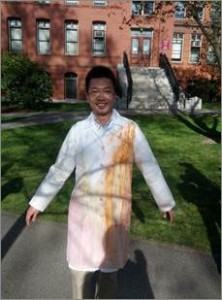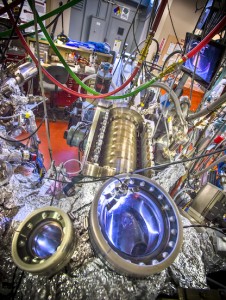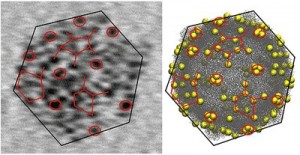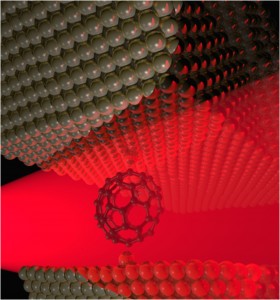Thanks to the researchers at Harvard University’s Wyss Institute for Biologically Inspired Engineering, I have discovered a new word, omniphobicity. Before getting to this new word, here’s a little more information about the project which spawned the word. According to a Jan. 14, 2014 news item on Nanowerk,
The researchers behind SLIPS (Slippery Liquid-Infused Porous Surfaces) have demonstrated a spate of sleek applications of the super-slick coating since unveiling it in a 2011 issue of Nature – and they just expanded its repertoire even more.
The Jan. ??, 2014 Harvard University Wyss Institute news release, which originated the news item, provides additional information about the SLIPS (Slippery Liquid-Infused Porous Surfaces) technology explaining the engineers have taken their inspiration from the pitcher plant rather the lotus, as is more common,
The team from Harvard’s Wyss Institute and the School of Engineering and Applied Sciences (SEAS) has demonstrated the uncanny ability of SLIPS – inspired by the pitcher plant – to repel nearly any material it contacts: water, ice, oil, saltwater, wax, blood, and more. They have demonstrated its versatility under extreme conditions of pH and temperature, and have successfully used SLIPS to coat everything from refrigeration coils to lenses, windows, and ceramics. What’s more, in 2012 they won an R&D 100 Award for the technology from R&D Magazine. This annual award honors the year’s 100 most significant products, the so-called game-changers of the technology scene.
Here’s what an image illustrating the pitcher plant and SLIPS,
![Inspired by the Nepenthes pitcher plant... [Image credit: New Scientist; Bohn & Federie, PNAS 101, 14138-14143, 2004] Courtesy Wyss Institute](http://www.frogheart.ca/wp-content/uploads/2014/01/PitcherPlant-254x300.jpg)
Inspired by the Nepenthes pitcher plant… [Image credit: New Scientist; Bohn & Federie, PNAS 101, 14138-14143, 2004] Courtesy Wyss Institute
The team’s latest work features cotton and polyster fabrics (from the news release),
And now, as reported January 10 [2014] in a special issue celebrating the 25th year of the journal Nanotechnology, the team has modified everyday cotton and polyester fabrics to exhibit traditional antifouling SLIPS behavior. The advance could meet the need for a robust, stain-resistant textile for a host of consumer and industrial applications.
“We took one page out of Nature’s book, and are finding that it has the potential to help us develop solutions to a variety of age-old challenges: ice we don’t want on refrigeration coils, bacteria that we don’t want on medical devices, and now stains we don’t want on clothes,” said Joanna Aizenberg, Ph.D., who leads the development of the technology. Aizenberg is a Core Faculty member of the Wyss Institute and the Amy Smith Berylson Professor of Materials Science at SEAS
Most currently available state-of-the-art, stain-resistant fabrics draw their inspiration and design from the lotus leaf. Tiny nanotextures on the surface of lotus leaves resist water, causing droplets of water to bead up on a cushion of air at the edge of the surface. Lotus-inspired textiles therefore use air-filled nanostructures to repel water. These are capable of repelling most aqueous liquids and dirt particles, but they suffer from a series of shortcomings, explained Cicely Shillingford, a Wyss Research Assistant and lead author of the Nanotechnology publication. They require a stable solid-air layer for the beading process to occur and thus fail easily under pressure – as in a heavy rainstorm – and do not withstand physical damage, such as twisting and abrasion, very well. They also stain more easily from organic or complex liquids, such as oil.
On the other hand, SLIPS is inspired by the carnivorous pitcher plant, which locks in a water layer to create a slick coating that causes insects that land on it to literally hydroplane and fall into the plant. The SLIPS coating anchors a slippery lubricated film infused to a nanoporous solid surface, creating a material that performs exceedingly well under pressure or physical damage, and can resist all kinds of liquids, including oil.
To create a fabric with SLIPS-type functionality, the team bought off-the-shelf cotton and polyester fabrics from stores near their lab in Cambridge, Massachusetts, and developed two ways to chemically treat them. One involved coating them with tiny particles of silica (SiM), and the other required a treatment with sol-gel based alumina (SgB). …
What happened after the team put the SLIPS-fabrics through a ringer of tests performed according to industrial standards – from twisting to rubbing and staining attempts?
“The SLIPS-fabric showed an unprecedented ability to repel a wide range of fluids and resist staining, and it handles physical stresses and strains just fine,” said Aizenberg.
While not every SLIPS-fabric was as breathable (yet) as the researchers hoped, it outperformed currently available stain-resistant fabrics on just about every other measure. As such, the most likely immediate applications could be fabrics needed in potentially extreme environments where breathability is not paramount but exposure to challenging contaminating liquids and biological hazards is involved, such as tactical suits for the military, lab coats, medical clothing, specialty garments for construction and manufacturing, and perhaps even tents and sports stadiums.
The scientists have also provided an image of a lab coat that was partially (sleeves) converted to SLIPS and than stained with a variety of foodstuffs,

Former Wyss Postdoctoral Fellow Tak-Sing Wong, Ph.D., who is now an assistant professor at The Pennsylvania State University, wears a labcoat in which the sleeves were converted to SLIPS, after sprayed with wine, tomato juice, eggs, and more. Courtesy Wyss Institute
Here’s a link to and a citation for the paper,
Fabrics coated with lubricated nanostructures display robust omniphobicity by Cicely Shillingford, Noah MacCallum, Tak-Sing Wong, Philseok Kim and Joanna Aizenberg. Nanotechnology 25 01 4019 doi:10.1088/0957-4484/25/1/014019
This paper is behind a paywall. As for an explanation of the word omniphobicity this abstract is helpful,
The development of a stain-resistant and pressure-stable textile is desirable for consumer and industrial applications alike, yet it remains a challenge that current technologies have been unable to fully address. Traditional superhydrophobic surfaces, inspired by the lotus plant, are characterized by two main components: hydrophobic chemical functionalization and surface roughness. While this approach produces water-resistant surfaces, these materials have critical weaknesses that hinder their practical utility, in particular as robust stain-free fabrics. For example, traditional superhydrophobic surfaces fail (i.e., become stained) when exposed to low-surface-tension liquids, under pressure when impacted by a high-velocity stream of water (e.g., rain), and when exposed to physical forces such as abrasion and twisting. We have recently introduced slippery lubricant-infused porous surfaces (SLIPS), a self-healing, pressure-tolerant and omniphobic surface, to address these issues. [emphasis mine] Herein we present the rational design and optimization of nanostructured lubricant-infused fabrics and demonstrate markedly improved performance over traditional superhydrophobic textile treatments: SLIPS-functionalized cotton and polyester fabrics exhibit decreased contact angle hysteresis and sliding angles, omni-repellent properties against various fluids including polar and nonpolar liquids, pressure tolerance and mechanical robustness, all of which are not readily achievable with the state-of-the-art superhydrophobic coatings.
If I understand it rightly the researchers are using the word omniphobic (omni meaning ‘all’ or ‘everything’) to imply that this surface repels liquids in many more situations, e.g. high-velocity stream of water (rain) than the superhydrophobic materials.
![Figure: Artist’s impression of a hot gas of magnetic monopoles in very cold surroundings. Eventually the surroundings suck the heat out of the monopole gas leaving it frozen at low temperature. [downloaded from http://www.london-nano.com/research-and-facilities/highlight/frozen-magnetic-monopoles-create-new-laboratory-physics]](http://www.frogheart.ca/wp-content/uploads/2014/01/FrozenMagneticMonopoles--230x300.jpg)
![Courtesy: HENN [Architects] [downloaded from http://www.henn.com/en/projects/culture/nanopolis-showroom]](http://www.frogheart.ca/wp-content/uploads/2014/01/NanopolisShowroomHenn-300x200.jpg)

![Courtesy American Chemical Society [downloaded from http://pubs.acs.org/doi/abs/10.1021/jf404402v]](http://www.frogheart.ca/wp-content/uploads/2014/01/CocoaBean-300x156.gif)


![Inspired by the Nepenthes pitcher plant... [Image credit: New Scientist; Bohn & Federie, PNAS 101, 14138-14143, 2004] Courtesy Wyss Institute](http://www.frogheart.ca/wp-content/uploads/2014/01/PitcherPlant-254x300.jpg)
